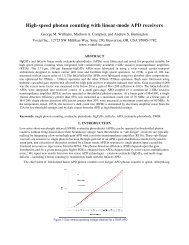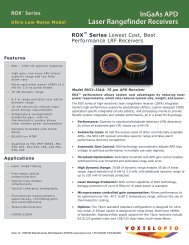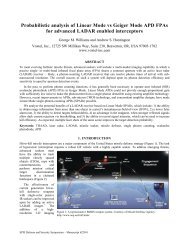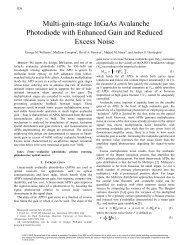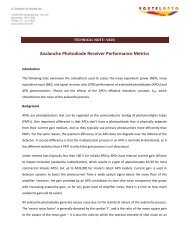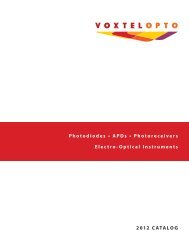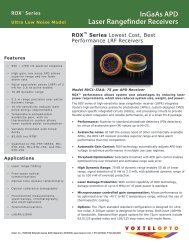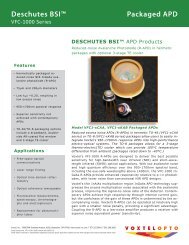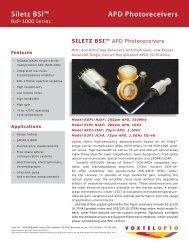Characterization of HgCdTe MWIR Back-Illuminated II-VI-07 ... - Voxtel
Characterization of HgCdTe MWIR Back-Illuminated II-VI-07 ... - Voxtel
Characterization of HgCdTe MWIR Back-Illuminated II-VI-07 ... - Voxtel
- No tags were found...
You also want an ePaper? Increase the reach of your titles
YUMPU automatically turns print PDFs into web optimized ePapers that Google loves.
temperature than the dashed curves, due to the additional effect <strong>of</strong> the reduction in ionization rate at higher<br />
temperature.<br />
The only other published data 28 for temperature dependence <strong>of</strong> gain in <strong>HgCdTe</strong> e-APDs are those <strong>of</strong><br />
the DRS group for a device with a cut<strong>of</strong>f wavelength <strong>of</strong> 2.63 µm at 300 K. Their data, also plotted in Fig. 4,<br />
show a similar dependence on temperature.<br />
Dependence <strong>of</strong> Gain on Diode Area<br />
In our e-APD Test Chip design, there is a family <strong>of</strong> widely-spaced circular diagnostic photodiodes<br />
with diameters ranging from 40 µm to 350 µm. We noticed a small but significant decrease in gain with<br />
increasing area among the variable-area devices within a given Test Chip. This dependence <strong>of</strong> the gain versus<br />
voltage curves on junction area is shown in Fig. 6 for four photodiodes from Test Chip 235G at 160 K. This<br />
dependence is also shown in Fig. 7, where the gains at -7.0 V for a set <strong>of</strong> variable-area diodes in this Test<br />
Chip at 80 K are plotted versus junction area. The gains at -7.0 V range from 50 for the largest diode to 70<br />
for the smallest.<br />
It is customary to use variable-area diodes 36 to determine the lateral optical collection length L OPT<br />
from the dependence <strong>of</strong> measured photocurrent on junction area. This is illustrated in Fig. 8, which shows<br />
data for the photocurrent, due to a 1000 K blackbody, measured at V=0 and 80 K for the variable-area diodes<br />
in the Test Chip <strong>of</strong> Figs. 6 and 7, plotted versus junction area. With no lateral collection, the measured<br />
photocurrent would be a linear function <strong>of</strong> junction area. With lateral collection, the smaller-area diodes have<br />
larger photocurrent than expected. The solid curve in Fig. 8 is a best fit to the data <strong>of</strong> the equation<br />
I PH =I PH-1D (1+L OPT /R J )², where I PH is the measured photocurrent, I PH-1D /(πR J ²) is the one-dimensional<br />
photocurrent per unit area collected by a diode with no lateral collection, and R J is the diode radius. The best<br />
fit to the data in Fig. 8 gives a value for L OPT <strong>of</strong> 12 µm, which is acceptably close to the 6 µm value calculated<br />
with the model for p-type <strong>HgCdTe</strong> described in our previous papers. 3,4<br />
We interpret the observed dependence <strong>of</strong> gain on junction area, shown in Fig. 7, as being due to each<br />
diode having two regions with different gains, an interior region with gain M 1D and an edge region with gain<br />
-11-




